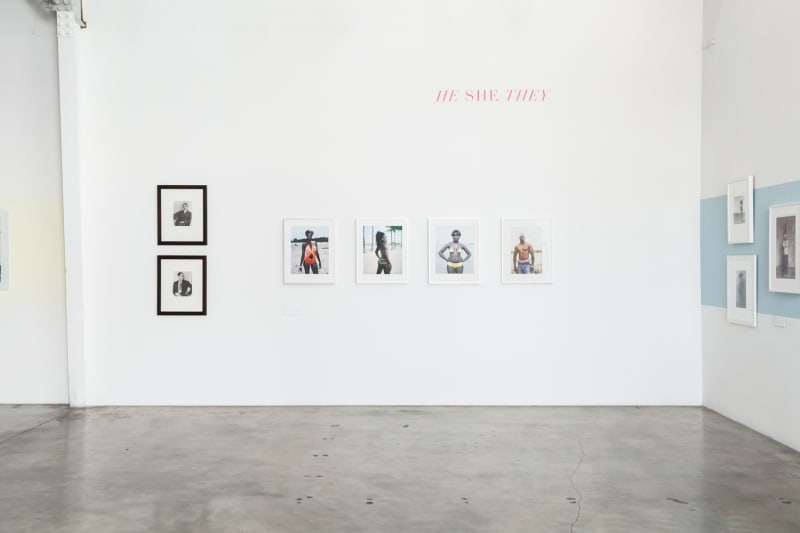HE / SHE / THEY collects the work of various photographers who utilize their own and others’ image to find what lies beyond the constructs of prescribed gender and sexual identity. With works by Manuel Álvarez Bravo, Diane Arbus, Nancy Burson, Andrew Bush, Antonio Caballero, Jo Ann Callis, Graciela Iturbide, Wayne Lawrence, Jocelyn Lee, Nikki S. Lee, Susan Meiselas, Yasumasa Morimura, Lise Sarfati, Tomoko Sawada and Katsumi Watanabe ROSEGALLERY presents HE / SHE / THEY, on view from 1 October until 30 November, 2016 with a reception on Saturday, 1 October, 2016 from six to eight pm.
Performance for the camera—and performing in life—involves mastering oneself. Yet identity exists within a plethora of expectations. Performing does not entail that each movement is made for the camera; rather, people create their identity and perform themselves through the participation in or negation of cultural roles. In the 1960s, Diane Arbus’ documentary work in New York and Katsumi Watanabe’s portraits in Tokyo both explored the lives of the ‘other:’ those who live the roles not prescribed to their bodies. Female impersonators, drag queens and androgynous people strike the eye as the juxtaposition between the expected and their choice of being defies gender expectations. Katsumi Watanabe’s photographs of drag queens, prostitutes, gangsters, and entertainers, created as portraits for the subjects themselves, are filled with the candid uniqueness of each sitter as they saw themselves, regardless of gender constructs.
Not always a question of the two distinct binaries of male and female, gender has existed with more fluidity in many societies. Long before the 2015 gay marriage ruling in the United States, the Navajo nation has supported various genders and sexualities; they believed in the presence of “two-spirit” individuals: those who do not identify with male or female roles. In Juchitán, the “queer paradise,” Graciela Iturbide photographed Magnolia, who identified as Muxe, Zapoteca for homosexual and genderqueer. Magnolia’s self-expressive portraits contrast with Manuel Álvarez Bravo’s portraits of Salvador Novo and Xavier Villaurrutia, which exert a masculine and refined image of the two Mexican writes.
Addressing the way female sexuality is often conflated with a certain form of femininity, Jo Ann Callis creates images that redefine gendered-sexuality. In Notes on Camp, Susan Sontag remarks that “The most refined form of sexual attractiveness (as well as the most refined form of sexual pleasure) consists in going against the grain of one's sex.” While Caballero’s collected nudes emphasize objectified distinctly feminine sexuality, Callis’ Early Color portfolio mystifies and the body in erotically charged compositions that blur the lines of sexuality and gender. While Burson’s photographs give life to often-sexualized plastic Barbies, the bodies in Callis’ photographs distill sexuality into a doll-like form, as if still lives of feminine, masculine and androgynous sexuality.
Gender, sexuality, and how we perform ourselves largely play into group identity. While quite different at first, the works of Wayne Lawrence and Susan Meiselas each seek identity through group performance, whether for a forward expression of feminism, or the ritual of going to the beach. Tomoko Sawada addresses the ritual of group aesthetics and questions of belonging in her Decoration series, wherein she dresses herself in recent fashion trends amongst Japanese teenagers. Even group identity exists within the artworks themselves; Yasumasa Morimura replaces cultural and art historical icons with his own body in his series Daughter of Art History. Yet group identity does not dictate how one participates. Nikki S. Lee has placed herself in the shoes of many in an effort to question the notion of static identity. In her Project series (1997-2001), she explores various american sub-cultures by posing herself within them. Describing individual identity as fluid, Lee exhibits the importance of aesthetics to identity by showing the possibility for one body to cross into various identities merely through appearance.
Through addressing the questions of sexuality, gender, personal expression, and identity, these artists relay the complexities of self-representation. With subjects that challenge the creation of identities based on gender and idealized norms, the artists’ works reflect the bourgeoning independence from the prescribed norms of gender and sexuality.

